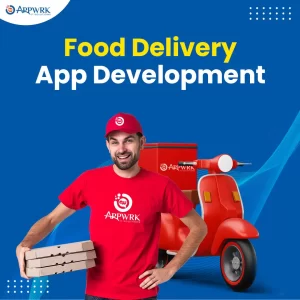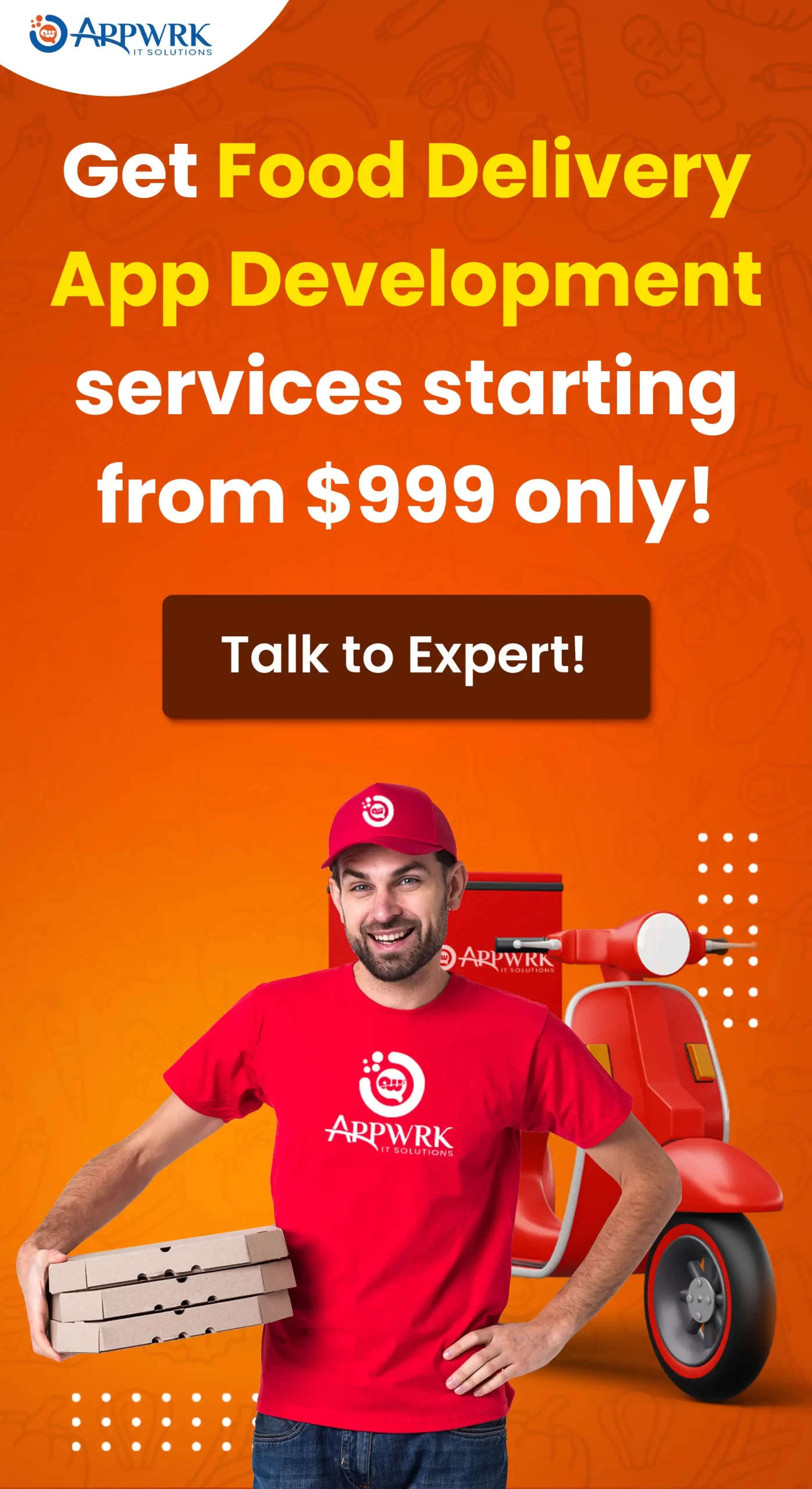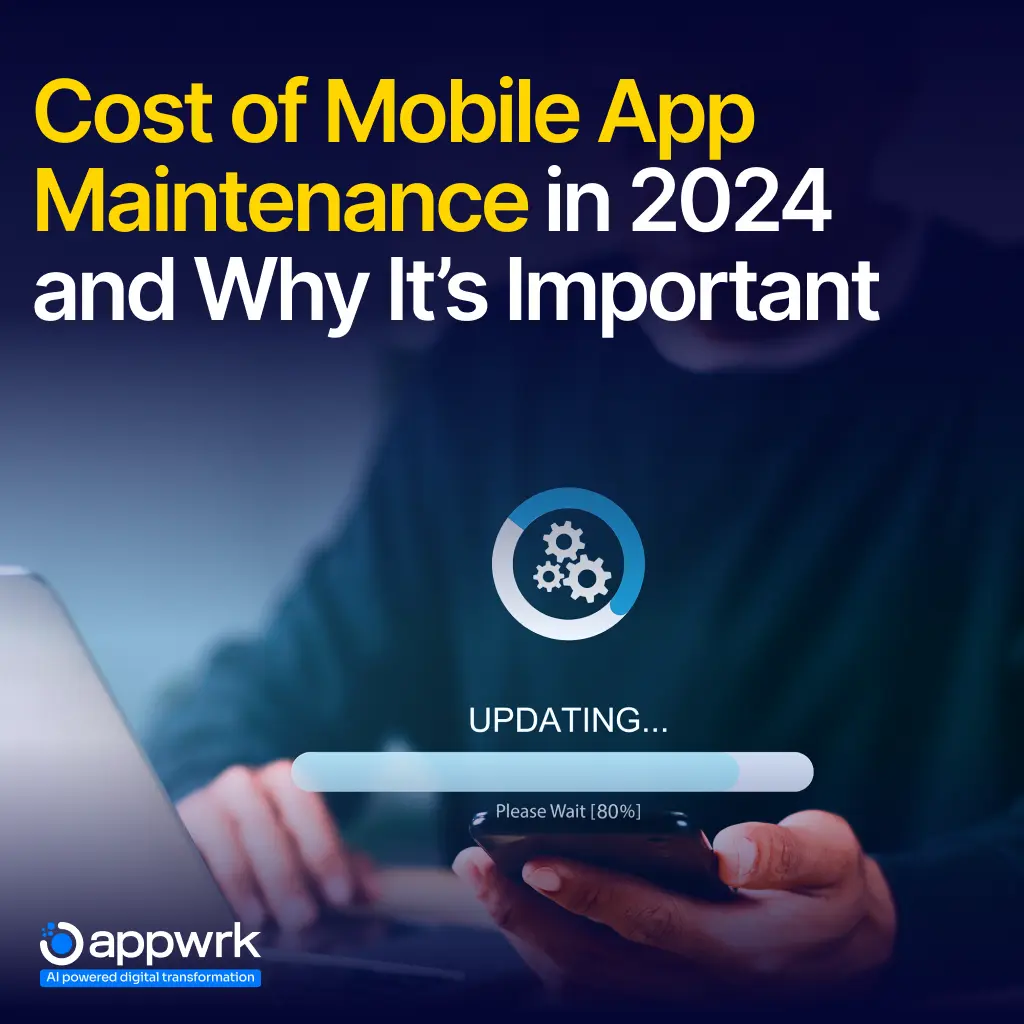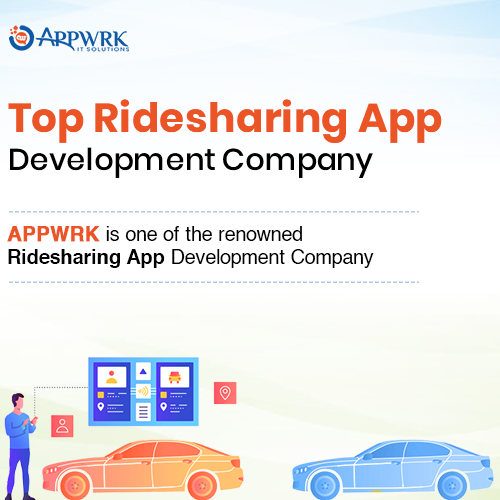Food Delivery App Development – Build an App Like DoorDash/ Uber Eats
Do you know that online food ordering now accounts for roughly 40% of the total restaurant sales? With the advent of technology, the online food ordering system has disrupted the traditional offline restaurant industry. The tech-savvy people with hectic life schedules who do not have time to go to restaurants and dine out have found a convenient food ordering system with the click of a button.
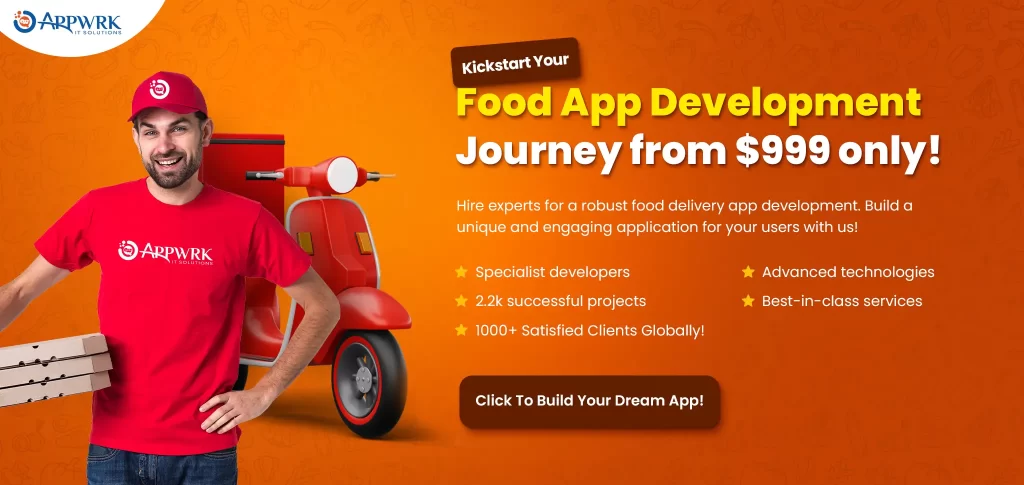
Today, eating in has become the new dining out! The food delivery services have given the liberty to the customers to browse thousands of restaurants and menus in one place and order anything from anywhere, anytime, hassle-free. With the industry projected to grow exponentially in the coming years, many entrepreneurs are venturing into the realm of food delivery app development.
This blog aims to guide you through the crucial aspects to build your own food delivery app – from market research, competitor analysis, defining your unique business model, selecting monetization methods, to reducing development costs by integrating various APIs. Buckle up and join us on this exciting journey of creating a successful food delivery app.
Table of contents
- Why Food Delivery Apps?
- How to Create A Food Delivery App?
- Know The Cost Estimation To Build Food Delivery App
- APPWRK IT Solutions: Upscale Your Business With Our Food Delivery App Development Company
- Conclusion
- FAQs
Why Food Delivery Apps?
The change from heading toward restaurants and cafes to ordering food online while sitting on the couch has given a massive boost to the food delivery industry in recent years. With this technological advancement, food delivery app development can help you grow in leaps and bounds with increased customer engagement and higher brand recognition. Let’s provide you with some insights.
According to the data provided by Statista:
- The US food delivery market revenue is expected to reach US $231.20 billion in 2023.
- Furthermore, the revenue is projected to grow at a CAGR (2023-2027) of 13.56%, resulting in a projected market volume of US $384.70 billion by 2027.

Let’s make you familiar with some other amazing facts about the food delivery industry:
- The number of smartphone food delivery app users in the USA was predicted to increase from 36.4 million users in 2019 to 45.6 million users in 2020. This growth was expected to continue, with an estimated 53.9 million users by 2023.
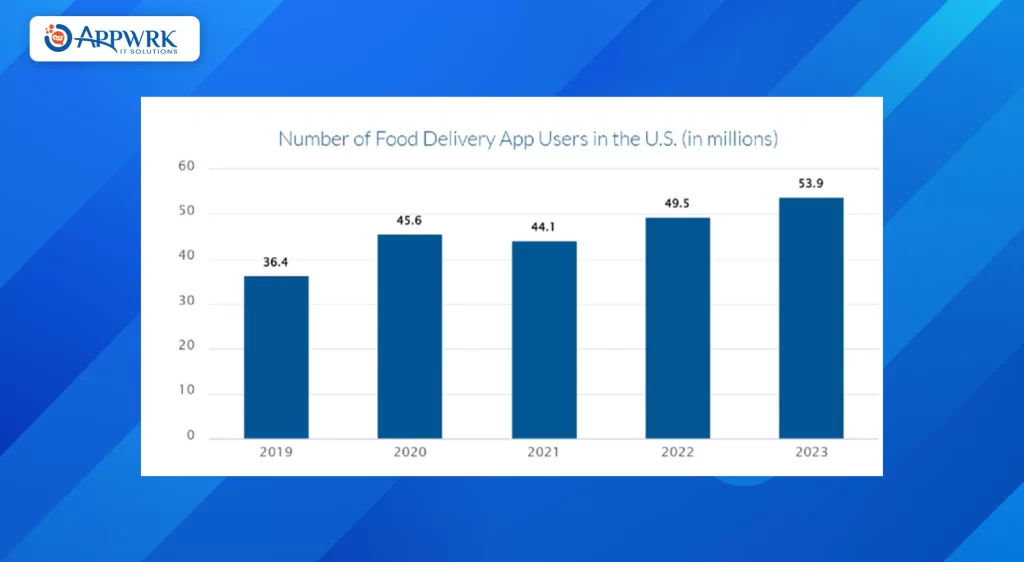
- 70% of customers want their food to be ordered online and delivered to their doorsteps.
- Almost 60% of food service operators say that offering delivery has generated incremental sales.
- One in three customers in the US use online food ordering services at least twice a week.
From the above facts, it must be clear that in this era of digitalization, developing a food delivery app, whether for a startup or a pre-owned restaurant and cafe, is the most profitable business you can ever opt for.
How to Create A Food Delivery App?
Food delivery app involves some crucial steps, so that you get a clear-cut understanding of various aspects, like your target audience, business model, revenue model, key delivery app features, tech stack, different APIs, and cost.
Market Research And Analysis
Do you know that DoorDash has dominated the food delivery market in the USA with 65% of the market share? Meanwhile, Uber Eats held the second-highest share, with 23%.
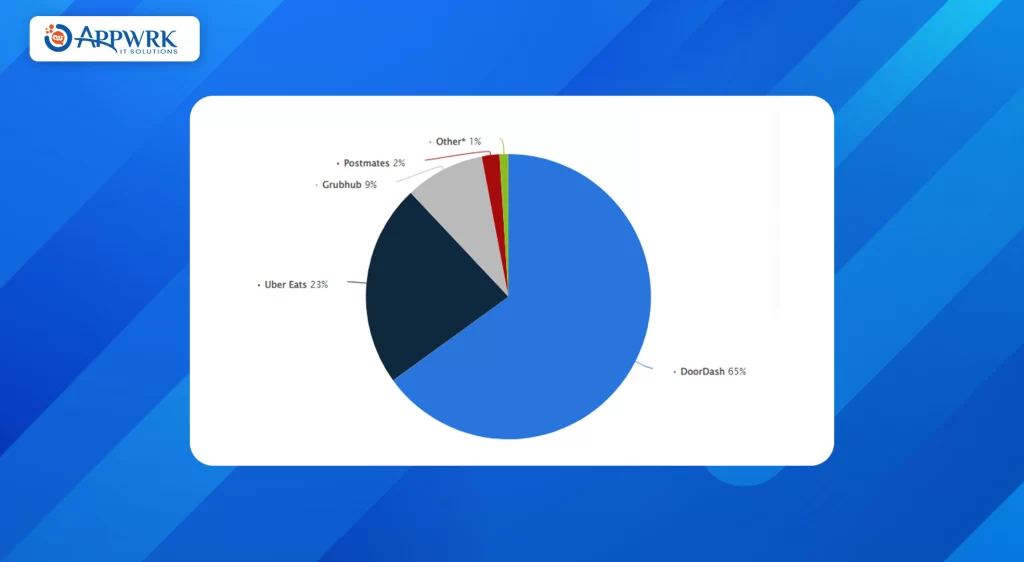
Analyzing your competitors in the food delivery industry will keep you one step ahead! It’s important to analyze successful and popular food delivery apps to know your target audience and understand their strengths and weaknesses. Consider their business models, features, user interface, customer service, and pricing. This will help you identify gaps in the market and opportunities to differentiate your app. Let’s know about some of the competitors that provide the best food delivery services.
DoorDash

Headquartered in San Francisco, California, DoorDash (Android, iOS) is a leading food delivery service app that connects customers to local and national merchants and offers door-to-door delivery. It not only provides you with the most exotic delicacies from the best restaurants and cafes but also provides other food delivery services like groceries, alcohol, and essential items. DoorDash serves more than 4000 cities across the USA, Puerto Rico, Canada, and Australia.
Uber Eats
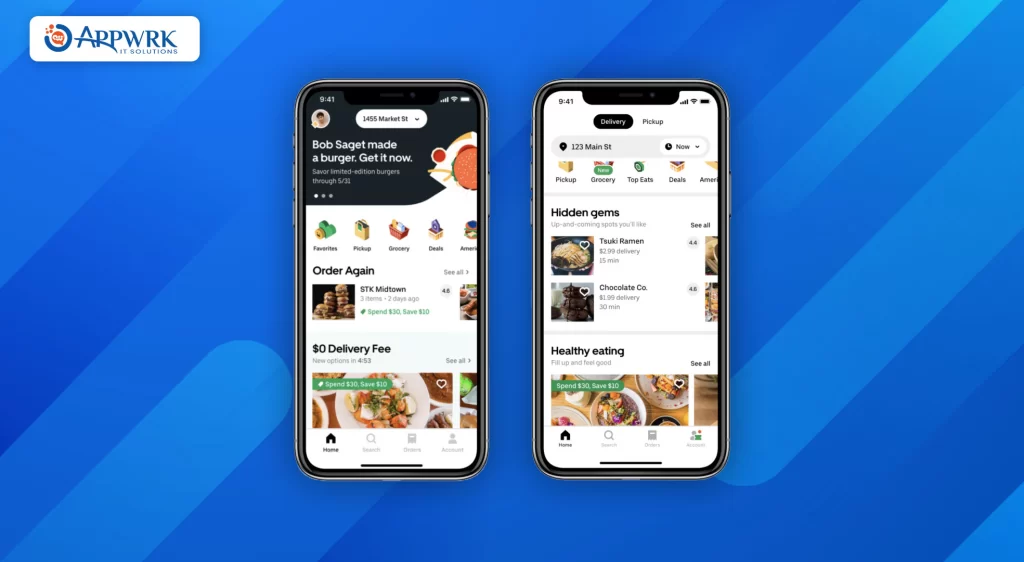
Launched by cab riding app Uber, UberEats (Android, iOS) is another leading food delivery platform where customers can browse menus, order food, provide feedback, make payments, and get food delivered to their doorsteps from thousands of listed restaurants. UberEats also offers a subscription plan for $10/month that waives the delivery fee from all orders. It has been providing its food delivery service to more than 25 countries worldwide, including Australia, France, and Canada.
GrubHub
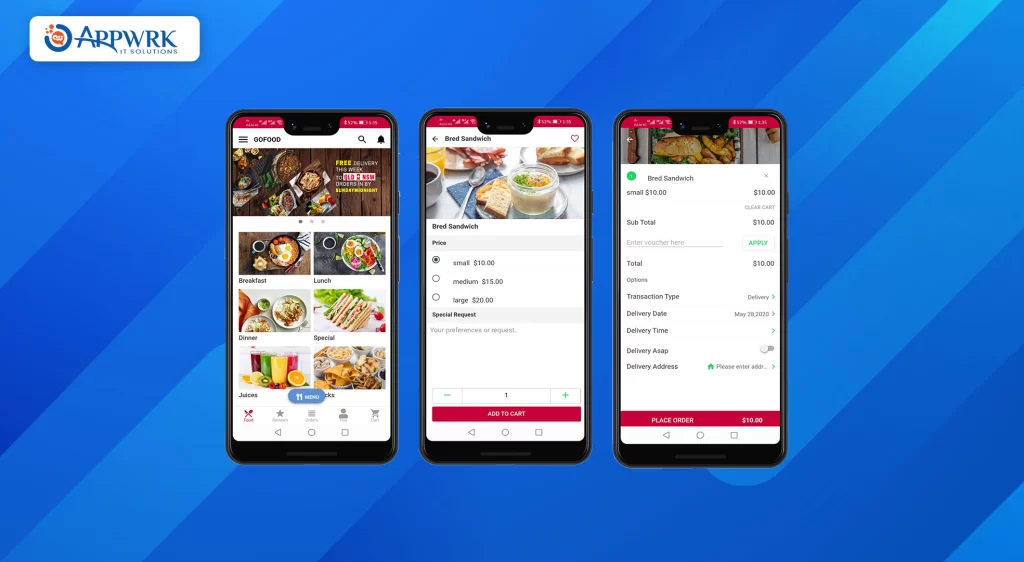
Owned by Just Eat Takeaway, GrubHub (Android, iOS) is a mobile food ordering and delivery app that has a network with almost 300,000 restaurants across 4,000 cities in the USA. The GrubHub app also offers fast deliveries and curbside pickup facilities to its customers. It also has a premium plan, GrubHub+, that gives access to unlimited free deliveries and premium features. Additionally, GrubHub has partnered with the largest sections of restaurants, including Sonic, Taco Bell, Burger King, and Dunkin’ Donuts.
Postmates

Postmates (Android, iOS) is another food ordering and delivery app that is owned by Uber. It provides delivery option on a wide range of products, including food, groceries, alcohol, and beauty products, to the customers’ doorsteps as soon as possible. It also offers a Postmates Unlimited plan, where users get various benefits like free deliveries and no small cart fees. Postmates now operates in more than 3,500 cities, serving more than 70% of US households.
Defining The Concept And Business Model
The next step is to define your app concept and decide on a business model to build an app like DoorDash and Uber Eats. It is necessary to know about the different business models so that you can make an informed decision of opting for a food delivery application, depending on your business goals. Let’s learn about three different business models:
Platform To Consumer Model/ Order Only Model
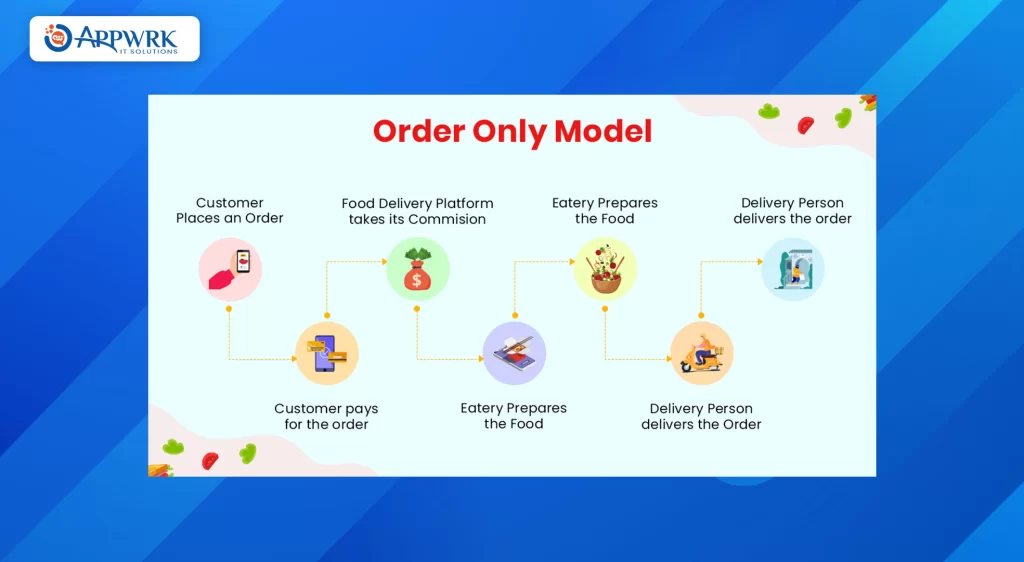
If you want to start a food delivery business, the platform-to-consumer business model is the best-suited option. This model uses the app as an intermediary between customers and restaurants. The restaurant or cafe owner is responsible for delivering the food to their customers, so you are not involved in logistics services.
Example: GrubHub (Android, iOS)
Delivery Service Aggregators/ Order and Delivery Model
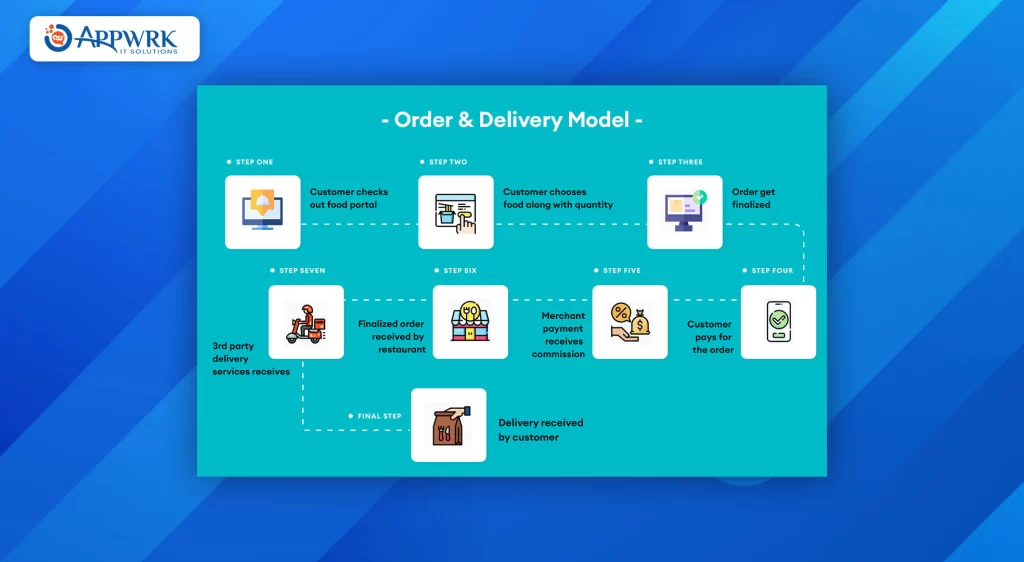
In this business model, food delivery app owners connect customers to various restaurants and cafes, but the app owners handle the logistics service. The owners partner with third-party delivery services that deliver food to the customers at their doorsteps. Therefore, the restaurants do not have to arrange a fleet of executives for the delivery operations.
Example: DoorDash (Android, iOS)
Full-Stack Model/ Fully Integrated Model
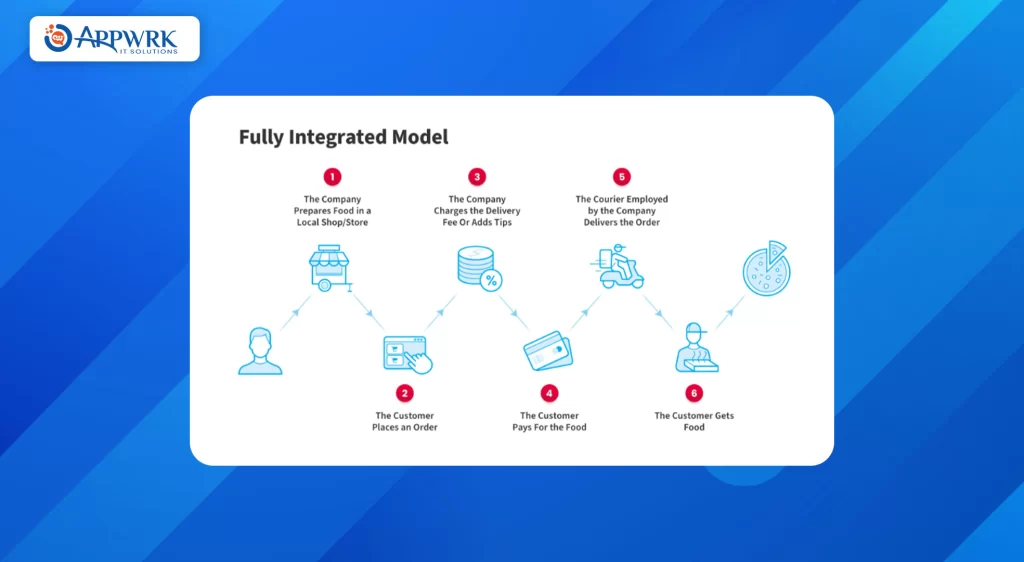
In this model, the restaurants own the entire value chain, from preparing the order to delivering the food to the customer’s doorsteps. As an example, McDonald’s offers food delivery options to its customers through its own app. They are responsible for every business operation, from taking orders to delivering them to the consumers.
Examples: McDonald’s (Android, iOS)
Choose A Suitable Monetization Method
Different revenue models for your food delivery application will help you earn higher profits, therefore, taking full advantage of these models is a must! Let’s give a glance at different models that will aid you in earning extra income through food delivery applications.
Delivery Fees
You can earn extra income through the delivery fees revenue model, where you can charge customers a minimal delivery fee on the orders placed through the food delivery app. You can charge different delivery fees depending on the time, location, demand, and other factors.
Advertisement
This is a common revenue model where you can earn extra by showing advertisements for other products related to food items in your app, which will attract customers to buy other products as well. You can earn extra money from the advertising business, thereby boosting sales.
Subscription
Another revenue model for your food delivery application is providing subscription plans to your customers. Customers can pay a minimal subscription fee, through which they can receive various offers and discounts weekly, monthly, or yearly basis. Also, you can provide them with other benefits like free deliveries and extra discounts that will encourage them to buy these subscription plans.
Commission
You can receive a commission from the restaurants and cafe owners on every order placed through the app and the sales they make on the food delivery platform. This is a widely used revenue model that helps you earn extra income by receiving commissions.
List Down The Essential Features
You must be aware of the fact that including all the necessary features is the heart and soul of an app. The following features will provide a strong hold on the functionality of the app. So, let’s dive in and learn about numerous food delivery app features that will help to enhance your app.
Customer Panel
- Sign Up / Registration: Customers can register and log in through email ids, passwords, and phone numbers for ease and convenience. Also, food delivery apps can be integrated with social media platforms for a faster login process.
- Nearby Restaurants: Customers can easily find nearby restaurants and the distances from their location through the online delivery app, making it easier for them to order food.
- Shopping Cart: Shopping carts in food delivery apps can help customers get an idea of the food quantity, price, and other details while ordering.
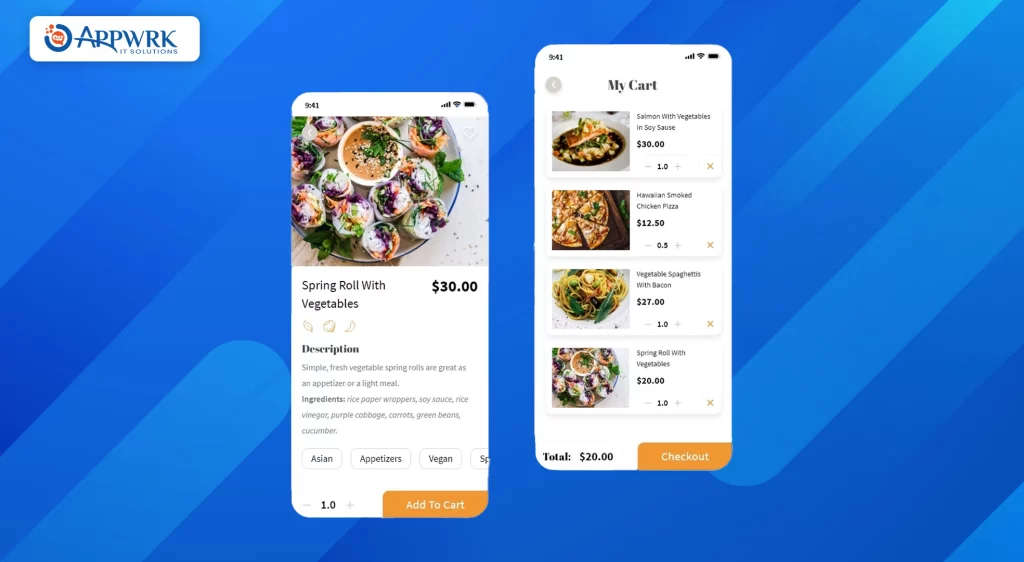
- Coupon Management: Customers can view and apply various discount coupons and codes during the checkout process in the food delivery app.
- Multiple Payment Options: Multiple payment options like debit cards/credit cards, UPI payments, mobile banking, e-wallets, etc., can help customers find their preferred mode of payment, providing them with a convenient checkout process.
- Order Scheduling: There are instances when people are not available at their homes and offices but want food to get delivered at a particular time, such as lunch and dinner timings. Food delivery apps can have an order scheduling feature so that customers can schedule when and where they want their food to get delivered.

- Order Tracking: Customers can track their order and know the delivery time and status in a real-time environment through the integration of google location API on-demand food delivery app.
- Push Notifications: Push notification feature in the food delivery application can keep the customers updated about various offers, sales, discounts, and other essential info, increasing customer engagement.
- Ratings and Reviews: The customers can rate and share their experiences without any hesitation in the reviews and ratings tab provided in the food ordering app. This will also help other users make an informed decision regarding purchasing food items from different restaurants.
Restaurant Panel
- Sign Up: Restaurants and cafes can easily sign up through email ids, phone numbers, and passwords.
- Manage Orders: The order management is one of the essential food delivery app features that can keep restaurant and cafe owners informed about the orders that are being placed in the app to provide delicious and fresh food to customers. Also, food service owners can keep track of their earnings on a daily, weekly, monthly, and annual basis.

- Manage Offers and Discounts: The restaurants can manage offers and discounts on food provided to the customers that will help in increasing sales, brand recognition, and customer loyalty.
- Real-time Tracking of Drivers: The restaurant owners can assign and track the location of the drivers in real time to ensure that the delivery time is not exceeded and the food is delivered at the correct location.
- Menu Management: There are times when some food items are not available with the restaurants. So, they can instantly change their menu rather than show their customers the “out of stock” title on their food items. They can also add and delete desired food items according to seasons and trends.
- Payment History: The restaurant owners can easily check the payment history made by the customers in a day to keep a record of the sales through the food ordering app.
Delivery Executive Panel
- Sign Up: Delivery executives can easily sign up through phone numbers, email ids, and passwords.
- Manage Orders: Delivery executives can be provided with delivery details so that they can check and manage the number of orders they have to deliver at a particular time through the food delivery application.
- Availability Settings: Delivery executives can change their availability to online or offline in a day.
- Real-time Tracking: Delivery executives can track the location of the customers in a real-time environment and also take the help of google maps so the food orders are delivered without any delay.
- Order History: Delivery executives can check the order history to keep a record of all the deliveries they have made on a daily, weekly, and monthly basis.
Choose The Right Technology Stack
Selecting the right tech stack for on-demand food delivery app development is an important step that will determine the functioning and design of your app. Therefore, you should be aware of the tech stacks that are used in food delivery apps so that it offers optimal performance and seamless interface to the users.
There are two main components of the tech stack:
Front-end
Front-end is for the clients, i.e., the customers can see and engage with the online store through the app. It is responsible for the mobile app’s design and navigation, providing a rich user experience and seamless user interface.
Front-end technology used for food delivery app development is Java or Kotlin for Android and Swift or Objective-C for iOS.
Back-end
Back-end is for the server side of software development. It refers to the app’s inner workings, which the users cannot see.
Back-end languages used for building food delivery apps are Python, Ruby on Rails, Node.js, and Java.
The table below shows some of the commonly used tech stacks used for food delivery app development.
| Mobile Platforms | Android, iOS, Cross-platform |
| API | Django REST Framework, Flask-RESTful, and Express. |
| Database | MySQL, MongoDB, or Firebase |
| Payment Gateway Integration | Stripe, PayPal, or Braintree |
| Push Notifications | Twilio, Nexmo, Plivo, Sinch, Apple Push Notifications Service (APN), Firebase Cloud Messaging (FCM) |
| Mailing Services | Gmail, SendGrid, ZeroBounce, MailGun, TempMail, FastMail, Firebase Cloud Messaging |
| Analytics and Tracking | Google Analytics, Mixpanel, Amplitude, Firebase |
| Cloud Services | Amazon Web Services or Google Cloud Platform |
Integrate Various APIs In Your Food Delivery App To Reduce The Cost Of Development
The development cost of a food delivery applications can be significantly reduced by integrating various APIs. These APIs provide ready-made services and functionalities that can be directly used in your app, thus saving development time and cost.
Uber Eats API
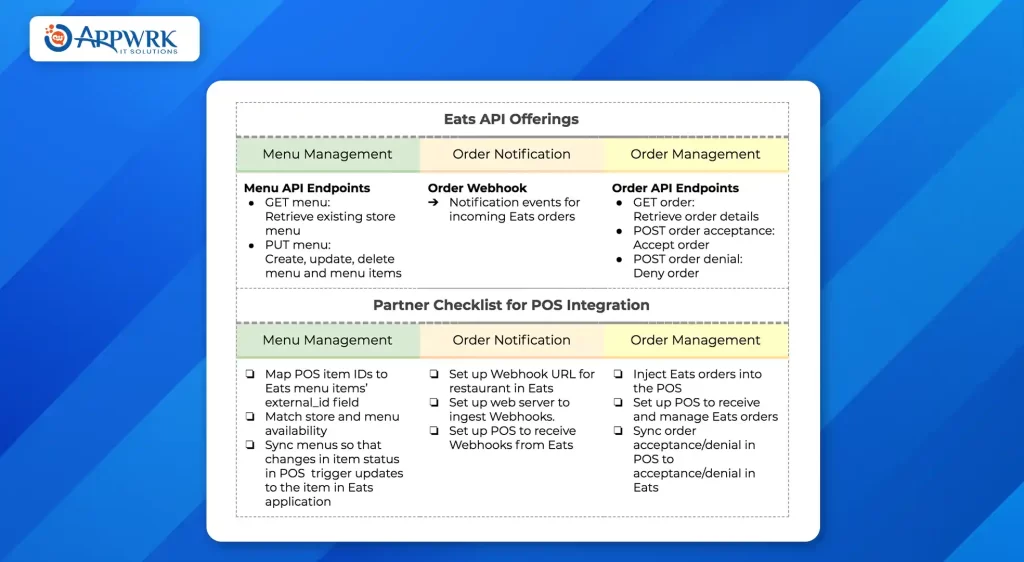
Uber Eats API provides access to a vast network of delivery partners. By integrating this API, your app can automatically assign delivery tasks to nearby UberEats delivery partners, saving you the cost of building and managing your own delivery network.
Cost: When vendors use the Uber Eats API, they are subject to a revenue-sharing model that takes a percentage of each order. This percentage can range from 15 to 40 percent.
Google Places API
Google Places API can help your app users discover restaurants and other places around them. It provides information about location names, addresses, ratings, reviews, and even photos. This saves you the cost of creating and maintaining a database of restaurants.
Cost: Google charges between $2 and $14 for every 1000 queries, with a maximum of 100,000 queries per day. Additionally, you can receive a monthly credit of $200 at no cost.
OneSignal API
OneSignal API is a service for sending push notifications. It’s essential for notifying users about their order status, discounts, new restaurant additions, and more. By using OneSignal API, you can avoid the cost of developing your own notification system.
Cost: If you have less than 30,000 subscribers, the OneSignal API is free and comes with limited support. However, if you have more than 30,000 subscribers, you will need to pay $99 per month to access the API.
FourSquare API
FourSquare API provides access to a vast database of restaurants, cafes, and other places, along with reviews and ratings. It can be a valuable resource for adding a review and rating system to your app without the need to build one from scratch.
Cost: The starting price of Foursquare API is $599, which is undoubtedly a valuable investment.
Google Distance Matrix API
Google Distance Matrix API is used to calculate the distance and travel time between different points on a map. This can be crucial for estimating delivery times and planning delivery routes, saving you the cost of developing such functionality.
Cost: Google Distance Matric API’s price goes from $4 and, similar to Google Places API, you can get the same $200 free credit.
GrubHub API
GrubHub API allows your app to access the GrubHub network of restaurants for placing orders. This can save you the effort and cost of individually partnering with restaurants and integrating their ordering systems.
Cost: GrubHub API follows a revenue-sharing model that ranges from 10 to 30%.
Mapbox API
Mapbox API provides detailed maps and location services. It can be used for displaying restaurant locations, planning delivery routes, and even tracking delivery personnel in real time. By using Mapbox API, you can avoid the cost of developing these functionalities.
Cost: Mapbox API is free for up to 25,000 monthly active users.
Freshchat API
Freshchat API is a modern messaging platform designed for businesses to communicate with customers. By integrating the Freshchat API, you can add a direct communication channel between your users and your customer support team within your app. This can greatly enhance customer service and help resolve any issues or questions users might have in real-time. As a result, you save on the development cost and time of building your own in-app chat system.
Cost: You can use the Freshchat API for free, but the usage is limited to 10 team members and 10,000 website visitors. If you exceed this limit, you will be charged $15 per month.
TomTom’s API
TomTom offers a range of APIs that provide mapping, tracking, and routing services. These APIs can be particularly useful for displaying restaurant locations, tracking delivery personnel, and calculating delivery routes and times. By integrating TomTom’s APIs, you can add these features to your app without the high development costs associated with creating such functionalities from scratch.
Cost: There is no charge for under 2,500 requests per day. If you need more, there is a fee of $25.
Know The Cost Estimation To Build Food Delivery App
Building a food delivery app requires time, money, and energy. The food delivery app development cost depends on various factors, which you should take into consideration for a cost structure. You can, however, make alterations to the factors depending on your requirement and budget. Let’s dive deep and know how much food delivery app cost you?

The food delivery mobile app development cost depend on various factors that are mentioned below:
- App complexity and features
- Team type you are hiring – In-house, Outsource, or Freelance
- Geographical location
- Mobile app platforms and development approach
- Number of third-party integrations you want to use in your meat delivery app
- App maintenance and support after the launch
Therefore, food delivery app development cost may vary depending on the above mentioned factors. If you want to develop a food delivery app from India, the cost starts from $999. APPWRK IT Solutions, one of the leading mobile app development companies, has successfully built many mobile apps globally, including for US clients, starting from $999. Contact us today for further assistance!
If your want detailed cost estimation and the factors affecting ecommerce app development cost, then dive into our blog: How Much Does It Cost to Build a Food Delivery App Like DoorDash/UberEats?
APPWRK IT Solutions: Upscale Your Business With Our Food Delivery App Development Company
To develop a robust food delivery app like your competitors, such as DoorDash and UberEats, you need a technically equipped mobile app development company that provides you with customized food delivery solutions with user-friendly features, seamless UX/UI design, and a robust tech stack. APPWRK is available 24/7 to listen to your business ideas and requirements and create an exclusive food delivery app to upscale your business!
APPWRK IT Solutions is a mobile app development company and a trusted partner in your long-term growth and progress journey. Our expert mobile designers and developers have completed over 2000 projects that have helped businesses scale up development, design, and digital marketing proficiency. Our team of mobile app developers possesses exceptional skills and technical proficiency, ensuring the creation of a tailor-made food delivery app that will undoubtedly lead you toward triumph in all your business endeavors.
Want a partner for your top-notch food delivery app development? Then jump into our blog post, Choose The Right Food Delivery App Development Company: Build An App Like DoorDash/Uber Eats to know about our development team structure, the process we follow, and much more!
What Our Clients Say?
Conclusion
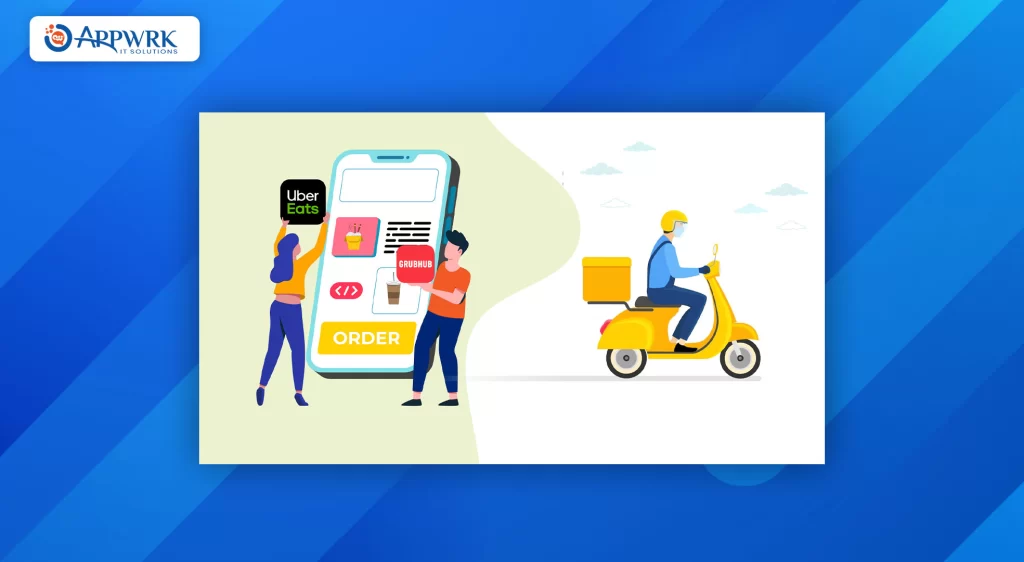
The food delivery market is rapidly evolving and expanding at a fast pace which has led to the emergence of food delivery app development. App development for your restaurant and cafe has become the need of the hour to survive in this cut-throat competitive world. A food delivery app will not only automate your food business but will also give you a boost to your sales and soar your profits!
There are thousands of food delivery services operating in the market, but to stay ahead in the race, one has to understand and analyze all the important aspects needed in developing a food delivery application. This detailed guide has covered all the essential points that should be taken into consideration. You have gained a thorough knowledge of the food delivery market trends, the meaning of a food delivery app, various business models that you can opt for, your top competitors, the cost needed to develop an on-demand food delivery app, and much more.
Furthermore, it is crucial to get in touch with the finest mobile app development company so that your food delivery business remains at the top. So, let’s grab this chance and develop a food delivery app to give wings to your business idea!
FAQs
The on-demand food delivery development timeline depends on the number of features and complexity. Furthermore, it also depends on the app development process, which has various stages. On average, food delivery app development will take an estimated time of 5-6 months. However, the timeline may vary according to the process, complexity, and number of features you want to include in your app. You can contact our food delivery app development company which will guide you and provide an accurate timeline for your business idea.
To develop a top-notch food delivery app like your competitors, such as DoorDash and UberEats, you need a technically equipped mobile app development company that provides you with customized food delivery solutions with key features, seamless UX/UI design, and a robust technology stack. APPWRK is available 24/7 to listen to your business ideas and requirements and provide you with the best food delivery app development services.
The on-demand food app development cost depends on various factors that are mentioned below:
App complexity and features
– Team type you are hiring: In-house, Outsource, or Freelance.
– Geographical location.
– Mobile app platforms and development approach.
– Third-party integrations.
– App maintenance and support after the launch.
– App security and testing.
Therefore, food delivery app development cost may vary depending on the above mentioned factors. If you want to develop a food delivery app from India, the cost starts from $999. APPWRK IT Solutions, one of the leading mobile app development companies, has successfully built many mobile apps globally, including for US clients, starting from $999. Contact us today for further assistance!
To create food delivery app, you need to understand the whole development process. You should know your market and competitors, define a unique concept, and choose an appropriate business model. You should be aware of basic features as well as key features diving it into various domains, which are customer app, restaurant app, and courier app. It’s also important to decide between an in-house or outsourced development team, considering factors like cost and project control. Additionally, integrating various APIs like UberEats, Google Places, OneSignal, FourSquare, Google Matrix, GrubHub, and Mapbox can enhance your app’s functionalities and reduce development costs.
The cost of building an app like DoorDash varies based on numerous factors. As a rough estimate, a basic version could start from $20,000 per platform, while a more complex app with advanced features might cost upwards of $200,000. These figures can change significantly based on your specific requirements and the development team’s location.

About author
